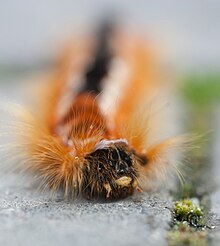Eutricha capensis
| Eutricha capensis | ||||||||||||
|---|---|---|---|---|---|---|---|---|---|---|---|---|

Eutricha capensis caterpillar |
||||||||||||
| Systematics | ||||||||||||
|
||||||||||||
| Scientific name | ||||||||||||
| Eutricha capensis | ||||||||||||
| ( Linnaeus , 1767) |
Eutricha capensis ( English : Cape lappet moth ) is a butterfly from the family of clucking (Lasiocampidae), which mainly in South Africa is widespread. The caterpillars feed on a variety of different plant species and are commonly found in gardens.
features
The moths have a wingspan of about 70 millimeters. The forewings are reddish brown and have yellow spots and three undulating white stripes that become longer towards the wing tip. The hind wings are also reddish brown. The larger females are usually paler in color than the males.
The caterpillars have, typical of the genus Eutricha , a black back stripe with white margins on the sides and with thorns. On the sides they each have a row of tufts with long, copper-colored hair. There are three reddish and two mauve tufts near the head.
Occurrence
The species is mainly found in South Africa, but is also found in Malawi , Mozambique and Tanzania . A number of natural habitats and gardens are settled.
Way of life
The moths appear in early summer. When disturbed, they behave very passively. The caterpillars live together in large groups on trunks. Contrary to what was assumed for some time, according to a study published in 2013, the aggregation behavior of the caterpillars has no advantage in terms of their water and energy balance, which is sometimes less favorable even compared to animals living individually. However, advantages such as better protection against predators and faster growth rates clearly outweigh these effects.
Food of the caterpillars
The following plants have been identified as food plants for the caterpillars: Acacia cyclops , A. mearnsii , willow leaf acacia ( A. saligna ), A. karroo , Bauhinia ( Bauhinia ), Celtis africana , Chrysanthemoides monilifera , C. incana , Monterey cypress ( Cupressus macrocarpa ), Combretum molle , Eucalyptus macarthurii , E. paniculata , Euclea racemosa , mango ( Mangifera indica ), Pinus patula , Monterey pine ( Pinus radiata ), P. elliottii , Montezuma pine ( Pinus montezumae ), poplar ( Populus ), Apricot ( Prunus armeniaca ), peach ( Prunus persica ), Rhus lancea , Peruvian pepper tree ( Schinus molle ), Brazilian pepper tree ( Schinus terebinthifolius ), pink banksiae and bald cypress ( Taxodium distichum ).
Systematics
Eutricha capensis was described by Carl von Linné in 1767 in the first volume of the 12th edition of Systema Naturae . Like many of the moths he described, he classified E. capensis in the now obsolete genus Phalaena . The epithet capensis refers to the distribution in the Western Cape province of South Africa .
Synonyms are:
- Phalaena capensis Linnaeus , 1767
- Phalaena pithyocampa Stoll , 1780
- Eutricha aluco Fabricius , 1781
- Eutricha pithyocampa Stoll , 1781
Web links
Individual evidence
- ↑ a b c d e f g Mike Picker, Griffiths, C .; Weaving, Alan: Field Guide to Insects of South Africa . Random House Struik , South Africa January 2004, ISBN 9781770070615 , pp. 346-347.
- ^ A b Carl Linnaeus : Systema Naturae ( Latin ), 12th. Edition, Volume 2 1767, p. 813.
- ↑ a b Eutricha capensis . In: African Moths . www.africanmoths.com. Archived from the original on November 4, 2013. Info: The archive link was automatically inserted and not yet checked. Please check the original and archive link according to the instructions and then remove this notice. Retrieved November 6, 2013.
- ↑ Ruben E. Schoombie, Boardman, L .; Groenewald, B; Glazier, DS; van Daalen, CE; Clusella Trullas, S; Terblanche, JS: High metabolic and water-loss rates in caterpillar aggregations: evidence against the resource-conservation hypothesis . In: The Journal of Experimental Biology . August 30, 2013. doi : 10.1242 / jeb.095554 .
- ^ Jurate De Prins, De Prins, W .: Eutricha capensis . In: Afrotropical moths . www.afromoths.net. 2013. Retrieved November 7, 2013.
